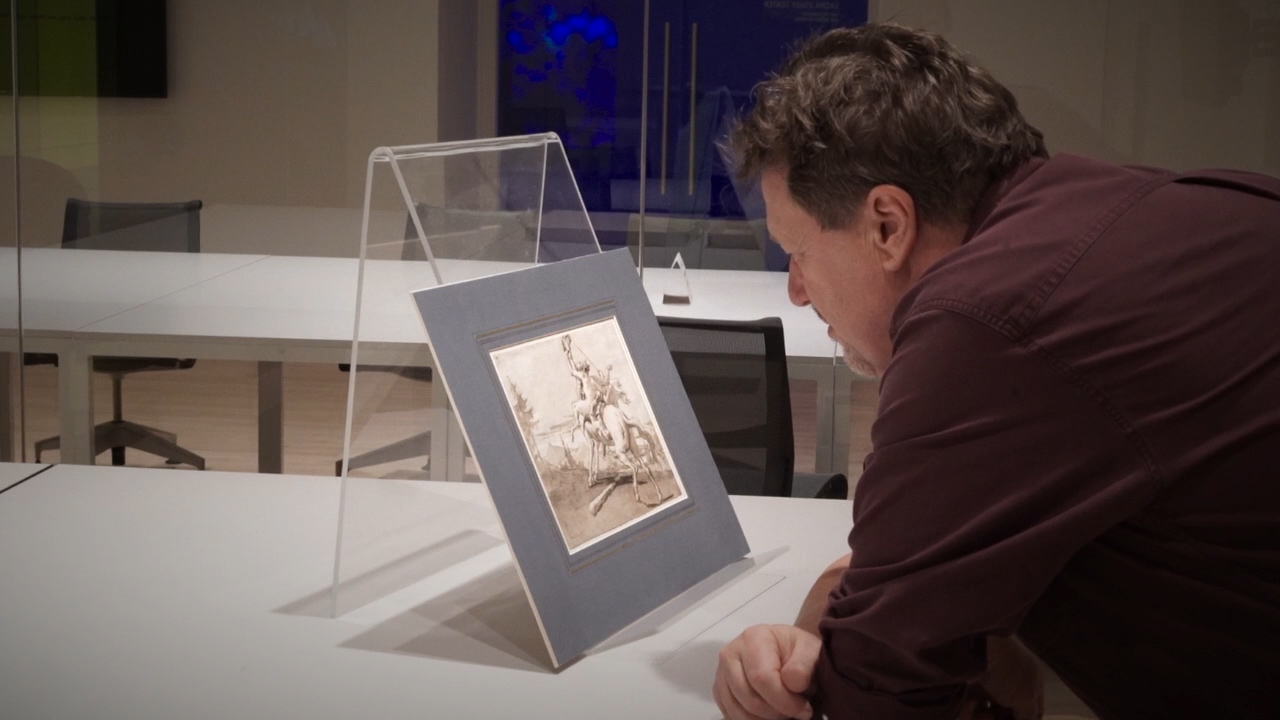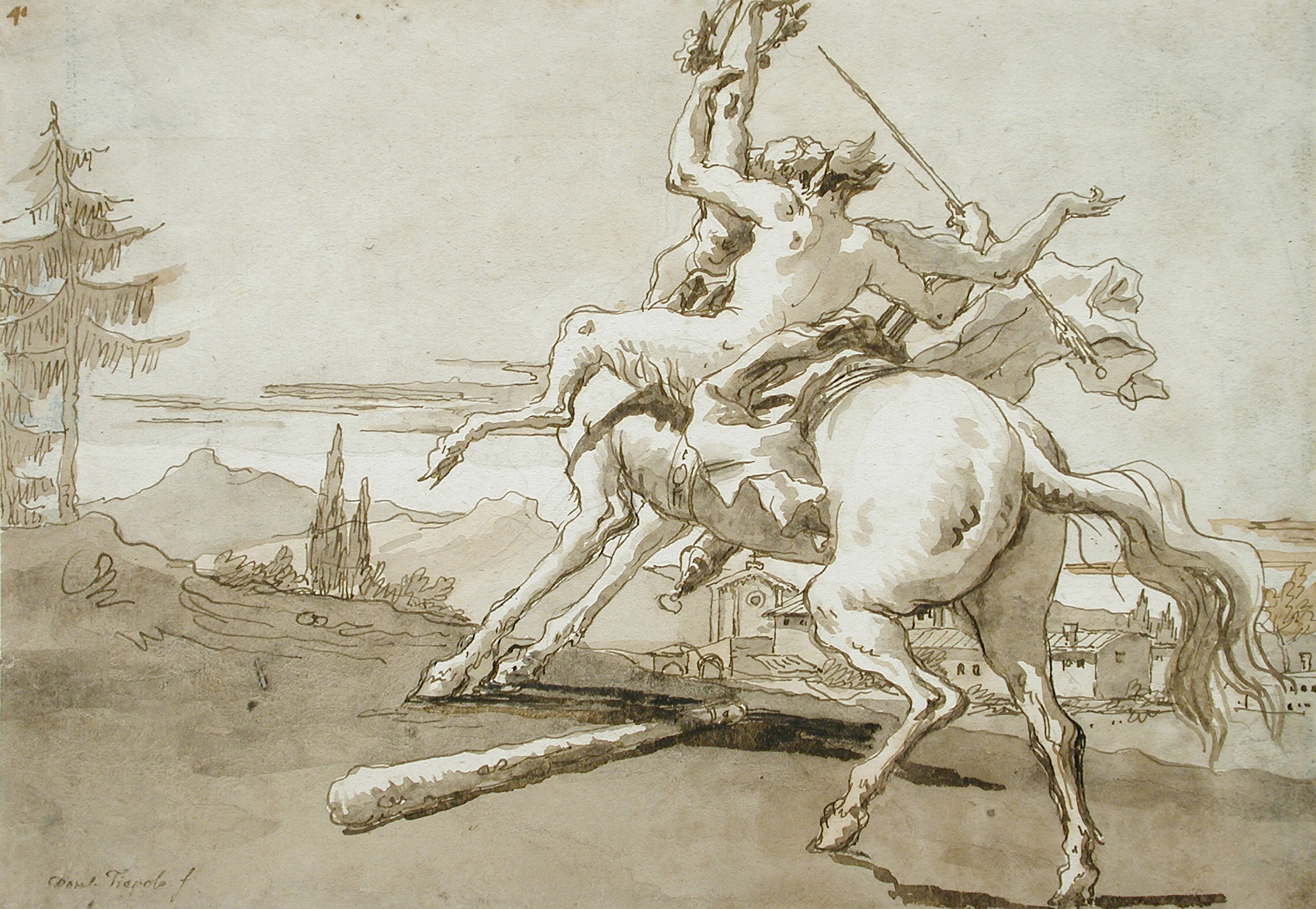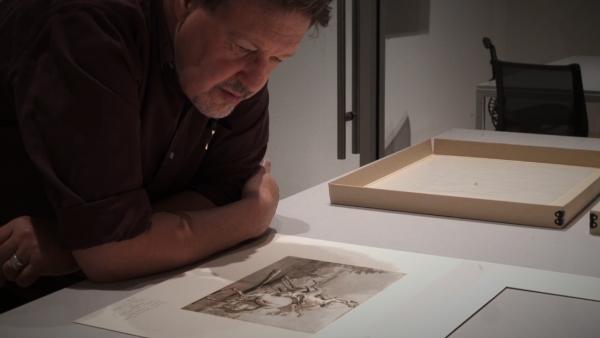Employing a range of media—oil paint, watercolor, gouache, collage, graphite—Tom Knechtel creates spectacular images. “I often think of my paintings as a kind of imaginary theater company,” he has said, which perfectly encapsulates their mesmerizing play of color, characters, and scenes. Knechtel lives and works in Los Angeles and teaches at Art Center College of Design in Pasadena.
For Artists on Art, LACMA’s online video series featuring contemporary artists speaking on objects of their choice from our permanent collection, Knechtel selected Giovanni Domenico Tiepolo’s Centaur Arrested in Flight, a Female Faun on His Back (c. 1759–91). Today, he speaks more about his connection to this drawing.
You chose this modestly scaled, ink-wash drawing to speak on today, when you could have spoken on a large-scale painting or something seemingly “grander” from LACMA’s collection.
Seeing really great drawings in person has made me aware of how there is a whole kind of intimate theater that one can stage in a drawing that is different from how a painting works. A painting is like a public address system. It’s like speaking across the room. A drawing like this is asking you to get really close, to step right up to it and think about it. I think Giovanni Domenico Tiepolo seemed to relish the idea of the intimate experience of drawing.

Tell us more about what you notice looking at a drawing up close.
I usually look to see things in the backgrounds or in the details that I would not get to see in a reproduction. I’m often looking to see something about the language of the making. How did the artist use the materials in a way that gives the materials themselves a voice, and how are they talking? I’m really interested in the idea that an ink drawing is really different from a pastel drawing, and a pastel drawing is really different from a graphite drawing. It’s like syntax. All these different materials are different syntax in different ways of speaking. They can carry certain kinds of content. Ink drawings, for instance, always seem to be drawings that are about things kind of blooming on a page and then disappearing.
We are looking at an 18th-century ink drawing today—how is the material speaking here?
This is an incredible drawing technically, in terms of the ability to do something that looks like it’s just kind of breathed out onto the paper. It looks so evanescent and so light, and the washes are filled with light. There is the sense that everything is in movement, it’s shifting, it’s disappearing. Lines are used as kind of skittering forms that hold shapes together as opposed to really bounding the whole form. It’s part of how the meaning of this drawing works. There are lots of artists of this period who can draw technically dazzling drawings but who don’t have the ability to be as moving.

You admire this drawings in two senses of the term moving—because it captures physical movement, and because you find it emotionally moving.
In this image, life is evanescent and things can just blow away. All the Tiepolo drawings are like people: turning and shifting.
It’s actually a little difficult to make out what’s going on in this image.
That’s what I love! [Laughing] Tiepolo draws things as if they were happening in front of him. I love the ambition of it—the idea that the artist doesn’t do the easier thing. He is doing the more difficult thing. And the thing is, he is respecting the viewer. That’s part of what keeps him fresh, his willingness to traffic in unanswerable mystery. There’s a dreamlike quality. The point of view is so odd you can’t figure it out at first. That’s the kind of thing that leads into surrealism in the 20th century.
How long have you been studying Tiepolo’s drawings?
I’ve loved the Tiepolos, the father [Giovanni Battista Tiepolo] and the son [Giovanni Domenico Tiepolo], since I was in college. When I was at CalArts in the early ’70s, Paul Brach was the chair of the art department and he taught a wonderful art history class. He used to talk about Giovanni Battista Tiepolo as the final gasp of Renaissance grand painting. And he had this wonderful thing he said: “This is how the Renaissance ends, not with a bang or a whimper, but with a flutter.”
You associate these drawings with learning as an artist?
Sometime in the ’80s, I began to really look at these drawings. I tried to do ink drawings like this and realized how hard it was. To do something where you work with such a light hand requires a kind of incredible confidence. You don’t have to dot all the i’s and cross all the t’s, that’s not part of how art works. You get something to a point where you launch it toward the viewer and then the viewer hopefully picks it up and carries it.
The conversation was edited and condensed for clarity.



